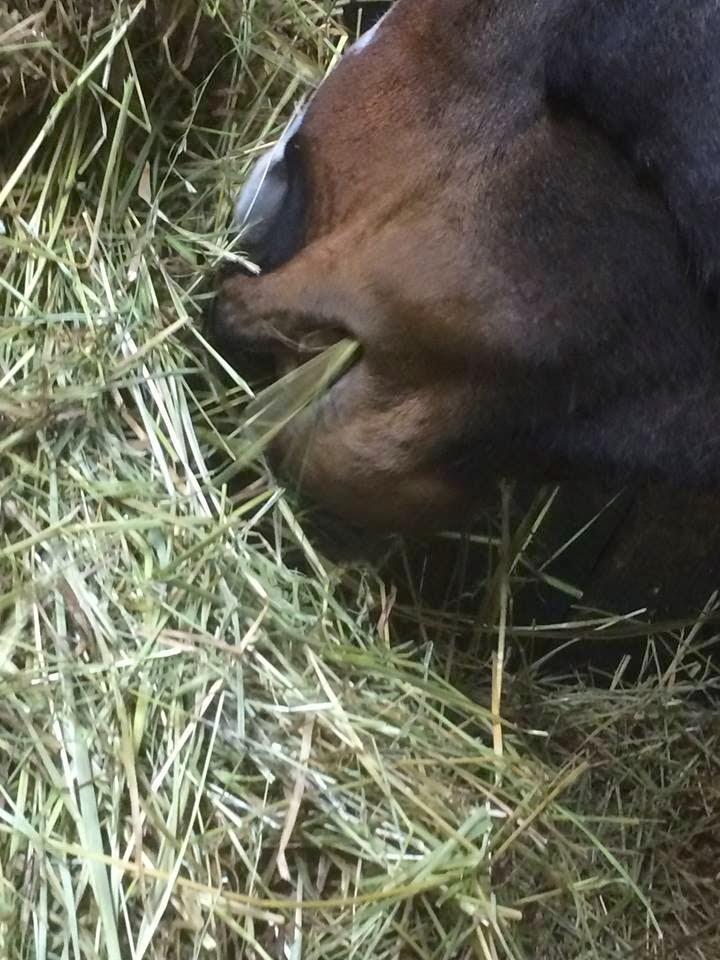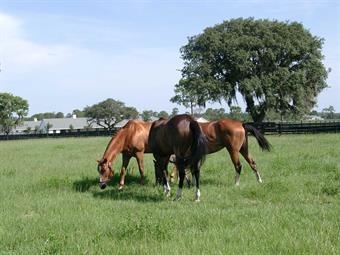Nutrients




 Nutrients
Nutrients
 For the racing stable
For the racing stable
The Horse, by nature a grazing animal

he horse is a grazing animal and its original environment where savannah or steppe. When the horse lived in a wild condition he could seek and eat of the herbs it needed to meet their nutritional needs.
Today the horse is dependent on humans to get their nutritional needs met. This has led to today's horses are often given inadequate feed because of ignorance or misguided benevolence.
Horse owners should seek knowledge about how the horse digestive system works and with this knowledge as a basis to decide what appropriate food for their horses are.
Hay
The choice of forage is of great importance, since it should always be the basis for all horse feeding programs. Hay is the best choice of forage for a horse. Grass hay will contain for example; timothy, fescue, orchard grass and perennial ryegrass. Legume hay will contain for example; clovers and lucerne. Nutritionally, there is no great difference between grasses and legumes, except for the higher content of protein and minerals of legumes and a higher content of carbohydrates (including fibrous components) in grass species. A horse should eat 2.5-3 % of its body weight of forage a day, so a horse that weighs app. 1,000 lbs. should eat 25-30 lbs. of hay a day. (Hay contains app. 14 % water, which means that the DM value is 86 %. The calculations above are based on hay.)
Compared to its body size, the horse has a small stomach. It is therefore important to feed the horse hay frequently (at least four times a day) or give it free access. Undisturbed free-ranging horses spend between 14 and 17 hours a day grazing. The grazing time is organized in meals separated by non-feeding intervals mostly used for rest. The non-feeding intervals are usually shorter than 2 hours and never exceed 3-4 hours. Stabled horses with free access to feed use the same amount of time for feeding and they organize this time in about 10 meals per day without any voluntary interruptions longer than 3-4 hours.
Whole Oats
Whole oats is considered to be the most suitable cereal grain for horses. It is the most palatable cereal and it is easy for the horse to chew. Oat has been found to have the highest digestibility of starch compared with, for example barley and corn. Whole oats are high in carbohydrates and are also the best fat source for horses.
Although the total tract digestibility of starch is high in horses, it has been shown that the capacity for starch digestion in the small intestine of horses is limited. This means that the capacity for starch digestion in the small intestine can be overloaded. Starch escaping digestion in the small intestine may alter the microbial fermentation in the hindgut, which could lead to digestion dysfunction. Therefore, the amount of starch is recommended not to exceed 2-grams/kilogram of body weight and feeding occasion. (A horse that weighs app. 1,000 lbs. should not eat more than 2 lbs. of oats per feeding occasion.) Feed 2 lbs morning and 2 lbs evenings.
Beet Pulp
Sugar beet pulp is the primary by-product remaining after extraction of sucrose from sugar beets. The similar energy content compared with oats and the high content of fermentable fiber make beet pulp an interesting feed for horses, with nutritional characteristics intermediate to forages and concentrates. Beet pulp is high in carbohydrates, fibers and calcium and low in phosphorus and it is therefore a good complement to oats. On account of its high water holding capacity, beet pulp is also an interesting alternative feed for endurance horses. Beet pulp every morning 0.5 lbs.
Sodium
Sodium is the only mineral substance that never can be found in sufficient amounts in natural feed (pasture, hay). Horses should therefore have free access to a salt lick.
Water intake
The horse is adapted to drink a high amount of water in a very short period of time. This goes back to the wild horse, which was very vulnerable for attacks from predators when it went to the water hole to drink. This behaviour is still present in the domesticated horse today. Even when the horse has free access to water it will drink in the same manner as the wild horse did.
Domesticated horses that are fed dry feed, for example hay, will drink water a couple of hours after they have been fed. A horse is able to drink at least 3 gallons of water per minute and more than 11 gallons a day. Studies in Sweden have shown that horses prefer to drink from bucket compared with automatic water cups and the horse can increase the water intake with up to 40 % when given water from a bucket. When the flow of water from the water cup is too low, they will drink too little water, so the water cups must produce at least 2 gallons of water per minute.
